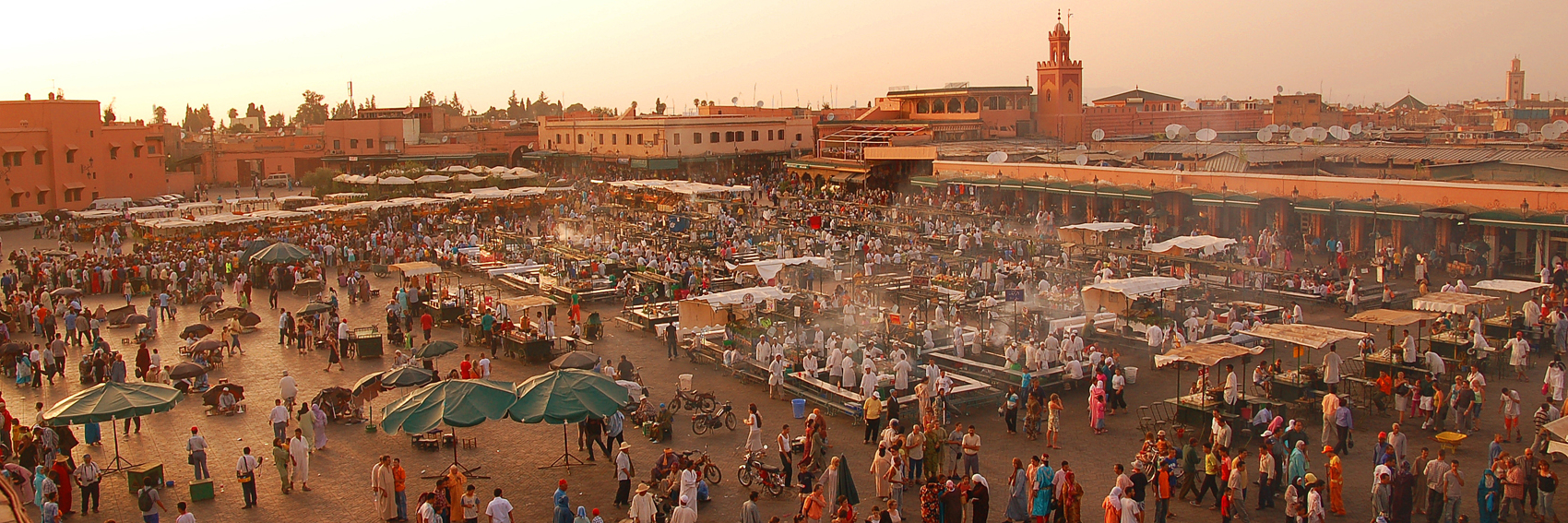
BY NATALIE WYATT
Marrakesh, one of the four imperial cities of Morocco, is almost unbearably hot in July. Each day, the baked desert winds roll in to the city – located on a plain beside the towering High Atlas Mountains on the outskirts on the Sahara desert – with a sort of dry heat that can make you feel like you are being cooked alive. Marrakesh’s oppressive heat reminds me of the fact that this city has been a major outpost for those who were long ago looking to cross the Sahara to trade with West Africa, when that trade route was one of the most important in the world, and linked the interior of the continent to the Mediterranean. Merchants rode from Marrakesh to Timbuktu in Mali, crossing the massive desert that was a sort of ocean, a body of sand that needed to be navigated skillfully with caravans of camels. Due to this history, Marrakesh is in some senses not that culturally separated from Timbuktu even though in reality it is a couple thousand miles away through some of the most dangerous conditions for travel. This is not to imply that there are no significant cities in between the two, for there most certainly are, but instead that they have became bookends to this centuries-long Saharan trade, and Marrakesh to some extent has remained a Saharan outpost to this day.
Many Moroccans lovingly call Marrakesh “the beginning of Africa,” due to its history as a sort of gate way to the Sub-Saharan regions of the continent. This West African influence can even be seen in the architecture of the city, which consists of clay-colored walls and low buildings, with the exception of the occasional Mosque. The main square, Jemaa el-Fnaa, harkens back to a sort of cross-continental market where precious metals and textiles from Mauritania to Nigeria would be displayed alongside Moroccan wares like carpets, herbs, and pottery. Even now, the bustling square feels considerably less European than many of the medinas in Northern Morocco, such as in Tangier or Rabat. Moroccans peddle Senegalese textiles or Ghanaian jewelry in Jemaa el-Fnaa. One man, wrapped in a turban and cradling a large snake, tells me he is from Mali. Marrakesh’s African influences make it truly feel like the first Moroccan city I have been to that reminds me I am actually on the continent of Africa, or at least the image of Africa that is portrayed to many Americans, of black Africa. It also reminds me that, though the Sahara is a huge impediment that portions off the Maghreb from the rest of the continent, the influences of West Africa have nevertheless made it across the desert and remain in Marrakesh to this day — even thousands of miles from its sister city in Mali.

Although Marrakesh is clearly a contact point for sub-Saharan Africa, it also presents a somewhat orientalist image of the region. In many ways, Marrakesh has been sculpted into an exotic city that creates industry off of this Arab-African symbiosis by marketing it towards the tourists who enjoy the unique feeling of this trading post city. Marrakesh feels not that different from Las Vegas, with its towering desert palms, strip of nightclubs, and carefully-constructed “authentic” Riads. This does not make the African influences in Marrakesh fake, but rather reminds me that, like many of Morocco’s cities, this transcultural identity can be used for profit because it is such a unique cultural contact point. Marrakesh is a city that quite literally has no rival in the Maghreb as an Arab-African trading point.
Despite this identity’s historical importance, though, Marrakesh is not simply a West African city, even considering its close cultural and historical proximity to the region. I worry that tourists may feel that by being in Marrakesh they have been in Lagos, or Accra, in some more accessible format. Marrakesh’s African influence is consciously constructed, or at least maintained, to garner this sensation. It is for this reason that one can enjoy the bustling souks and squares of Marrakesh, and marvel at the sheer number of wares with influences both Arab and African, but understand that this is a carefully maintained cultural contact point…not simply a West African city, or in any way a clear representation of the vast and diverse regions in sub-Saharan Africa. For now, Marrakesh is a historical borderland whose history and cross-cultural identity can be appreciated by locals and tourists alike.